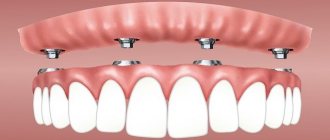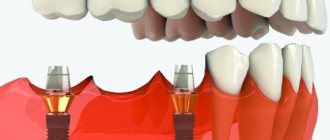One of the most popular modern technologies for restoring lost teeth is implantation. It appeared more than half a century ago and since then has been continuously improved, offering new materials and components, expanding the range of implants, developing simpler and more effective surgical protocols, increasing efficiency and safety.
Let's look at the pros and cons of dental implants. Today it is a painless and safe procedure that provides a number of advantages over other types of prosthetics:
- wide possibilities of prosthetics – with the help of implantation you can restore one tooth, several, and even the entire dentition,
- preservation of bone tissue - without chewing load, the jaw bone gradually atrophies, and implants, transferring the load to the jaw, stop this process,
- excellent aesthetics - any crowns can be installed on implants and the appearance of artificial teeth will be no different from natural ones,
- careful treatment of natural teeth - implantation does not require grinding down neighboring teeth, it does not affect them at all, and even (preserving the jaw from atrophy) prevents displacement and loosening,
- ease of use – implants feel exactly like your own teeth, you can easily get used to them in 1-2 days and do not cause any discomfort,
- complete restoration of chewing function and diction - there are no restrictions on food intake for implants (except for the period of their engraftment).
Of course, implantation also has some disadvantages, such as pain and discomfort in the first days after surgery, a rather long period of complete engraftment of the material, a small risk of complications (2-3%), as well as high cost, but nevertheless, implantation is becoming more and more is widely used as the cost of this procedure decreases and components become more accessible to the general public.
How are dental implants done today?
Almost all patients who decide to undergo this operation are concerned about the question of how dental implantation works. The procedure involves the following steps.
- An implant is placed in the prepared hole, then it is covered with a gum flap, sutured and wait until it integrates. Healing of the implant takes several months: about two or three - on the lower jaw, from four to five - on the upper jaw.
- A small circular incision is made in the gum and a gum former or abutment is installed on the implant and loaded with a temporary crown.
- Impressions are taken, a permanent crown is made and installed on the implant.
Immediately installing a permanent crown is not recommended, as it puts strong pressure on the implant, which leads to its rejection. The two-stage technique is ideal for smokers and patients who do not take good care of hygiene - bacteria will not be able to penetrate into the closed socket, and the risk of implant rejection will be minimized.
The two-stage method is most often used to restore already missing or traumatically removed teeth, when there is not enough bone tissue in the area where the implant is installed. In these common situations, bone volume needs to be increased. Sometimes this manipulation can be carried out simultaneously with the installation of the implant, but most often it is necessary to postpone the implantation for several months and wait until the required volume of bone tissue is formed.
The process of installing a dental implant before and after
Important points when choosing superstructures
The patient may refuse to install the former; the technology provides for this option. But in the end, at the final stage, the aesthetics of the smile will suffer when using prosthetic teeth in the frontal zone. Lack of proper gingival contour boundaries will result in incomplete closure of the base of the artificial root. The resulting gap will contribute to the accumulation of bacterial plaque, which is difficult to clean.
When choosing abutments, you need to consider the following factors:
- when using metal-ceramic prosthetics, a titanium superstructure is suitable;
- it is preferable to install a zirconium dioxide crown for the anterior section on an abutment made of the same material to avoid unaesthetic translucency;
- Custom-made abutments are better than standard analogues, since they take into account the anatomy of the patient’s dentofacial apparatus.
The absence of a clearly formed gum contour when refusing a former or choosing an unsuitable abutment is dangerous due to the formation of a deficiency of gingival tissue.
What are the latest dental implant technologies?
One-stage
Today, an implant can be installed in just one day. This modern technology is called one-stage implantation. Do not confuse it with one-stage, these are two fundamentally different methods. Single-stage implantation is carried out immediately after tooth extraction, and during a one-stage procedure, a temporary crown or gum former is installed simultaneously with the implant. The one-stage method is most often used when restoring the frontal group of teeth, so that the patient does not feel embarrassed about his smile. In addition, installing a temporary crown or former at the same time as the implant helps to correct the shape of the gums, which plays an important role in creating an ideal smile.
Together with tooth extraction
Single-stage dental implantation - how does it happen? Such an operation can be carried out only under ideal conditions: if the tooth was removed atraumatically, there are no inflamed hard and soft tissues left in the socket, and there is sufficient bone tissue present. If the conditions are unsatisfactory, bone material is poured into the hole, and after a couple of months, two- or one-stage implantation is performed. Moreover, in some cases, a one-step technique can become a one-stage one. For example, if the implant is installed into the bone with a certain force, and there is no severe inflammation in the patient’s oral cavity.
By template
New technologies for dental implantation, such as surgery using a surgical template, make it possible to correctly position implants in the oral cavity. Before the procedure begins, a special template is made for the patient, which is sent to the computed tomography department, where the template is scanned, and then the patient along with it. Next, the computer models are combined in a special program. The resulting stencil allows you to first work with aesthetics, that is, determine where the crowns or dentures will be placed, and only then place implants under them. This unique technology helps to achieve an excellent visual effect, accurately install implants even in areas with the minimum allowable bone volume, without affecting vessels and other anatomical formations, and also reduce the procedure time. Using a surgical template before dental implants is ideal for patients who are missing all or several teeth in a row.
Options for installing alternative implants
All installation methods discussed above are intraosseous – that is, implants are placed inside the bone tissue. The method is considered optimal - and currently all modern implants are installed this way. The metallic root becomes, in the full sense, a replacement for the natural one. The implant has a very similar shape, is located in almost the same place in the bone as the natural root (or affects additional deeper areas - as with basal and zygomatic installation).
But there are other options.
Intramucosal method of implant installation
The installation of intramucosal models does not take place in the bone, but only in the gum and slightly under it (so that the structure does not fall out). These implants are more like buttons rather than analogues of roots - after implantation, a prosthesis will be installed on such a “button”. Now the technique is already a thing of the past due to its low service life and the occurrence of complications (trauma and inflammation of the gums).
Endodontic-endosseous method
Another outdated method is endodontic-endosseous. Here, a thin awl-shaped implant, like a pin, is inserted into the root canal of the tooth, then partially extends beyond the root and is strengthened in the bone. The technique was used to fix a loose or broken tooth. But practice has shown that endodontic-endosseous implantation is difficult to perform, is not suitable for long-term restorations, and is applicable only in a very narrow number of cases (in single-rooted teeth with canals of a certain width).
Mini implantation
Mini-implantation can be classified as an intraosseous technique, but miniature and thin models sink into the bone very shallowly and therefore become loose over time. The fixation of the prosthesis, which also becomes mobile over time due to the wear of the fastenings, does not add comfort. Therefore, the global implantology community considers mini-implantation only as a temporary solution - while a person undergoes treatment. For example, if there are contraindications to more reliable methods of implantation.
How does implantation proceed from start to finish?
Let’s simulate a situation where the patient has previously undergone an examination and comes to the clinic directly for implantation. How does dental implantation proceed in this case? First, he is given anesthesia, local and not general. Even the longest operation does not take more than two hours and does not require such a serious type of anesthesia as anesthesia for dental implantation. Further, the procedure regulations depend on the type of implantation: if we are talking about a two-stage technique, then first the gum is cut, a hole is made in the bone, an implant is installed in it, which is covered with a flap, and then suturing is done. All of the above manipulations take no more than fifteen minutes. If the operation follows a template, then the installation of each implant takes no more than ten minutes, since no cutting of the gums or suturing is required.
Single-stage and one-stage implantations last a little longer, since they require either tooth extraction or the installation of a crown or gum former.
Technology for installing dental implants in pictures
Implants should be installed in a sanitized oral cavity, so visiting a therapist and hygienist will not be a bad idea. Consulting doctors are also competent in how dental implantation proceeds; they will treat caries and remove all dental plaque, thereby minimizing the risk of implant rejection.
Stage 1. Preparation
The scheme according to which the stages of dental implantation are arranged necessarily provides for preparation, which, in turn, provides for the following:
- sanitation of the oral cavity (treatment of caries and periodontal diseases);
- checking the condition of the maxillary sinuses for the presence of inflammatory processes and cysts;
- X-ray examination of the jaw bone tissue to assess its condition;
- the patient undergoes tests prescribed by the dentist to assess the general condition of the body.
It is no coincidence that diagnostic studies are one of the stages of dental implantation. After reviewing their results, the dentist eliminates the presence of contraindications, which helps reduce risks and avoid complications in the future.
How many implants are needed and which ones to choose?
Installing ten implants on each jaw is an ideal solution for patients suffering from complete edentia. However, a good result can be achieved with eight or even six implants. More economical options are removable dentures on four implants. The most budget-friendly alternative is a removable denture on two implants. Some patients believe that two or four implants will not be able to withstand the load placed on them during jaw work and will be rejected. In fact, the pressure during chewing is distributed throughout the entire prosthesis and falls not only on the implants, but also on the bone and gum, so there is no need to fear rejection.
The choice of product depends, firstly, on the volume of bone tissue. If there is a lot of bone, then any implant can be installed, and if not, then only a certain size. Secondly, from the methodology. Thus, it is possible to carry out one-stage implantation only if the implant is tightly fixed in the bone. To do this, either its rod or thread must be of large diameter. Not all companies produce such aggressive implants, so the patient has not much choice. And thirdly, from the budget.
What is the implant installation method?
This means how the implant will be placed in the bone, what processes precede it and what processes complete it. And, starting the story about the methods of installing dental implants, you need to immediately understand the classification of this very installation. We will put the following factors into separate groups:
- preparation of the bone bed for the implant: flap method, minimally invasive, innovative laser,
- presence/absence of bone tissue atrophy: vertical or inclined installation,
- what type of bone will the structure be implanted into: cancellous, basal and cortical plate, into the zygomatic bone and other parts of the skull,
- the tooth was removed a long time ago or removal is still only in the plans - here the installation of an implant can be combined with this process,
- what implantation method is used.
Do I need to follow certain rules after surgery?
After the procedure, you must follow all the specialist’s recommendations. In the first two to three days, you should not rinse your mouth in the area of the implant, since blood cells that promote its healing are washed out from the operated area. However, it is still necessary to clean the implant installation area, although very carefully. To do this, you can use special brushes with soft bristles and a paste with an antiseptic effect. For three to four days after the operation, you should not exercise, carry weights, or visit a sauna, bathhouse or solarium. And - most importantly - if any unpleasant or abnormal sensations occur, you must immediately contact your dentist. If you carefully care for the implant and follow all recommendations, it will last you a lifetime.
Who can undergo implantation and who cannot?
Implants cannot be installed in girls under eighteen years of age, and in boys under twenty-one years of age, since during this period the bone is still forming, and implantation can disrupt this complex process. As for the upper age limit, there is no upper age limit for installing implants. Absolute contraindications include disorders of blood clotting and bone regeneration. It is prohibited to perform the operation on pregnant women and people with an unbalanced psyche. In all other cases, implantation is possible.
Vertical and inclined installation
Most implants require exclusively vertical installation. And if several of them are placed, then the doctor must observe the principle of parallelism. But in some situations, implants can also be implanted into the bone at an angle of up to 45 degrees. Here, the main indication for inclined installation is a lack of bone height or low density due to atrophy or inflammatory processes. Angled placement allows for a larger area of bone to be used for contact with the implant surface. And also bypass areas of atrophy and anatomical structures (nerves or sinuses), and exclude additional bone grafting surgery[1]. True, not all implants are designed for this – and this must be taken into account.
What is the cost of dental implants?
The process of dental implantation is quite complex, with many subtleties and nuances. Therefore, its price is appropriate. In dentistry, the minimum cost of a South Korean implant and its installation is 18,000 rubles. It comes with a five-year warranty, but with adequate care it will last you a lifetime. German implants are more expensive - from 30,000 rubles, but they have a lifetime guarantee. The cost of implants for a one-step technique is 36,000 rubles. The price list of premium level products starts from 42,000 rubles. Additional manipulations, such as bone grafting, are paid separately. Bone tissue augmentation costs from 18,000 rubles to 40,000 rubles, depending on the complexity of the operation. The cost of a temporary crown is 12,000 rubles, a permanent one - from 18,000 to 34,000 rubles. Dentures on implants cost from 64,000 to 190,000 rubles.
How much does it cost on average in Moscow?
Many clinics do not calculate the cost by stages and estimate the costs of implantation on a “turnkey” basis.
| Name of service | Cost, rub. |
| Dental prosthetics | |
| With metal-ceramic crown | 39100 |
| With all-ceramic crown | 50200 |
| With a ceramic crown on a special alloy | 60000 |
| Prosthetics with removable dentures | |
| With ball mount | 54700 |
| With beam fastening | 160000 |
| Prosthetics for a toothless jaw | |
| on 4 implants | 350000 |
| on 6 implants | 450000 |










